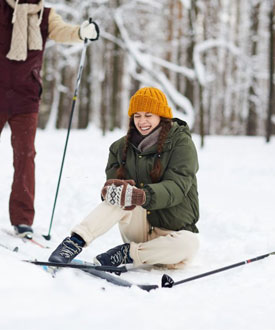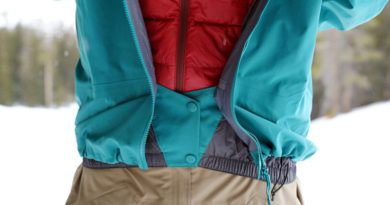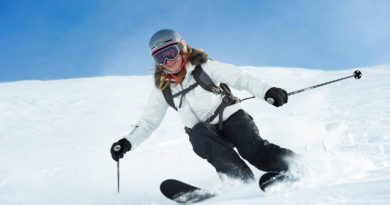5 Useful Skiing Tips for Fat and Overweight People
Skiing is fun and if you are a bit fat, don’t worry, you can still ski and enjoy your time. Skiing has a lot of mental and physical health benefits, and skiing is a great way to lose some pounds. With a full day of skiing, you can burn up to 3000 calories and that’s a lot! Skiing also helps strengthen your muscles and boosts your immune system. It also combats depression and anxiety. So, you can be fat and still ski unless you are a massively obese person who has limited movement. There’s no upper weight limit for skiing. However, you can ski happily if you are fat and feel fit.
Below I have mentioned some useful tips for fat and overweight people thinking about getting into skiing. So keep reading.
1. Be aware of your knees
Skiing put a lot of pressure on your knees and the more overweight you are the worse it’s going to be. All the big skiers I have seen so far had some sort of knee problems. Also, big skiers can ski for a limited time each day. There are a number of knee problems that skiers face but the most common for fat skiers is the Runner’s Knee. It causes when you put too much pressure on your knees for an extended period of time. Runner’s Knee causes pain around the front aspect of your knees. You feel pain when walking up or going down stairs, squatting, kneeling, or sitting.

To prevent ski-related knee problems, make sure you are utilizing effective skiing techniques. For example, keeping hands and weight forward, legs parallel, and hips, knees, and ankles flexing equally will ensure your knees get less impact and you are preventing other injuries as well. Also, stay on well-marked trails because going off-trail means there will be obstacles like trees and rocks that can contribute to knee-related injuries. Finally, take rests so your knees are relaxed every time you start skiing. Injuries happen more commonly when you are tired and fatigued.
2. Find the right outerwear
Choosing the outerwear that fits you well is important for a successful day on the slopes. This includes your jacket, pants, and boots. There are jackets and pants available that are built especially for plus-size people. A well-fitted jacket keeps you warm and provides protection against snow and wind. Pants, on the other hand, keep your lower body warm and protected. Also, plus size outwear is somewhat difficult to find and brands may not have your size available readily. So, it is important to prepare ahead of time rather than finding the fit a day before your trip.
The fit of your ski boots also matters because they fit differently than regular boots. Since you are a big guy, you also have big feet and you certainly want a bigger pair of boots. You may also have larger calves, which presents a problem with boot fit. So look for a pair of boots with a wide calf or a pair that can be adjusted to a broader setting. You can also seek professional help and they will make sure your boots fit you well. So take your time and find the right pair for you because it’s important to find the right pair before hitting the slopes.
3. Learn to recover from falls
One of the biggest problems you will face being a fat guy is recovering from falls. For a light and nimble person, it is very easy to prop up. But for a heavy and fat person, it sometimes needs to reach down and pop your skies off so you can stand up. The worst part is falling on a flat surface because it is easier to stand up if you fall on a steep surface. You just need to push off the hill and be up. It becomes even worst if you are a big person. The more weight and momentum you have the higher the risk of injury will be.
Recovering from a flat surface
Even though it is counter-intuitive, recovering from a flat surface is much harder than recovering from a steep surface. If you fall on a flat surface, you need to do the following things:
- Orient your skies downhill so that they are perpendicular to the hill or fall line.
- Push yourself with the help of your arms and ski poles.
- If you can’t push yourself, don’t struggle too much, and don’t feel bad about yourself.
- You can pop your skis off because standing with the skis removed is much easier.
- You can then pop into your skis after you stand up.
Recovering from a steep surface
Falling on a steep surface is much different than falling on a flat surface. This also means you are an advanced skier skiing on the steeper terrain. If you fall on a steeper surface, do the following:
- The first thing to do is to get yourself stopped so you don’t slide further and hurt yourself. To do this, dig your arms and legs into the snow and your skis also. This way, your body will not slide further.
- Once stopped, get your skis below you perpendicularly just like you did on flat terrain.
- You can now push against the snow with the help of your hands to prop yourself up.
- If your arms aren’t reaching the snow, you can use your ski poles and that will help.
- You can still remove your bindings and skis if nothing works.
Remember, you are a big guy and you have more weight and momentum. The risk of injury during a fall will also be higher. So take your time and practice skiing before hitting the slopes.
4. Find the right length of skis
The length of your skis depends on your height and weight. Finding the right length of skis is as important as finding the right fit of boots. However, if you are a beginner skier, always choose shorter skis. On the other hand, if you are an intermediate or advanced skier, you will want longer skis. Shorter skis are easier to turn because a shorter turning radius allows for shorter turns. They are also lightweight and you can do tricks easily with shorter skis. Longer skis, on the other hand, are more stable at high speeds and they float better in powder due to a larger surface area. The below table compares skier weight, height, and length of skis:
| SKI LENGTH | SKIER WEIGHT | SKIER HEIGHT |
|---|---|---|
| 145 cm | 100 to 110 lbs. | 4’10’’ to 5’ |
| 150 cm | 110 to 115 lbs. | 5’ to 5’2” |
| 155 cm | 115 to 125 lbs. | 5’2” to 5’4” |
| 160 cm | 125 to 135 lbs. | 5’4” to 5’6” |
| 165 cm | 130 to 140 lbs. | 5’6” to 5’8” |
| 175 cm | 140 to 160 lbs. | 5’8” to 5’10” |
| 185 cm | 160 to 180 lbs. | 5’10” to 6’ |
| 195 cm | 180 to 200 lbs. | Over 6’ |
One more thing to remember is that soft snow deforms under your skis if you are a heavy person. So it is always a good idea to consider wider skis. The wider skis will flatten out the irregularities and you will experience your skis being more stable underfoot. 145-150mm is the range where wider skis fall. This range is measured at the waist of the skis. Anything wider than this is also going to put too much force on the ankles even in the soft snow. So you need to strike a good balance between width and performance.
5. Don’t always go for wider skis
Even though wider skis perform better in soft snow, you should not use wide or fat skis all the time. Wider skis put a lot of pressure on your knee joints. They have edges more offset from the centerline of your leg and knee. So when you turn, you are almost riding on the edge of your skis. Due to this offset, you get more bending moments into your knees. So as mentioned earlier, you need to strike a good balance between the performance and width of your skis. Finally, don’t choose wider skis as your daily driver for skiing groomers. Only use your wider skis in fresh snow conditions.
Frequently Asked Questions
There are some questions that fat skiers often ask about skiing:
Can fat people ski?
Yes, fat people can ski pretty well. However, being a heavy person just makes things harder. But with the help of the right techniques, gear, and outerwear, you can ski without any issues. You also need to choose wider skis as snow deforms under skis if you are a heavy person. Finally, be aware of your knees because it is the most common problem that fat skiers face.
Do skis have a weight limit?
Different skis have different weight limits. Most ski shops have skis readily available for up to 200 pounds. So, if you are over, 200 pounds, it doesn’t mean you are too overweight for skiing. It just means that the shop will have a difficult time finding skis that will suit your weight.
Is there a weight limit for skiing?
There is no specific weight limit for skiing. The weight limits you see on the charts are for ski gear like your skis. However, skiing can present some unique challenges if you are an overweight skier. You can overcome these challenges by preparing yourself before going to the mountains.
Are there weight restrictions on ski lifts?
Chair lifts have no sign mentioning individual weight limit. A chair lift is designed to hold multiple people. These lifts can carry anywhere from 2 to 8 people. So if you are a heavier person, don’t worry about the chair lift weight limit.




